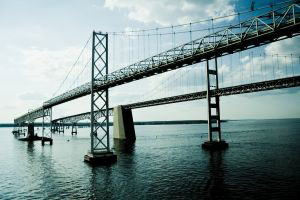Lesson: Suspension Bridge Building
(Provided courtesy of Society for Women Engineers)
Level: Grades 5-12. Time required: 60 minutes: lecture and preparation time, 15 minutes; lesson: 45 minutes.

Photo by Rich Niewiroski Jr.
SUSPENSION BRIDGE CONSTRUCTION
OBJECTIVES:
• Students build a model of a suspension bridge and test the amount of weight it will support.
• Students will be able to identify different types of bridges: suspension, arch, girder, truss, cantilever, cable-stayed and moveable.
• Students will learn materials can be positioned in specific patterns to form a stronger structure.
NATIONAL SCIENCE STANDARDS:
Physical Science:
Properties And Changes Of Properties In Matter (5-8)
Motions And Forces (5-8)
Structure And Properties Of Matter (9-12)
Motions And Forces (9-12)
Science As Inquiry:
Abilities Necessary To Do Scientific Inquiry
Science and Technology:
Understanding About Science and Technology
STANDARDS FOR TECHNOLOGY LITERACY:
The Nature of Technology:
• Students will develop an understanding of the characteristics and scope of technology.
• Students will develop an understanding of the core concepts of technology.
Design:
• Students will develop an understanding of the attributes of design.
• Students will develop an understanding of engineering design.
Abilities Of A Technological World:
• Students will develop abilities to apply the design process.
The Designed World:
• Students will develop an understanding of and be able to select and use transportation technologies.
• Students will develop an understanding of and be able to select and use construction technologies.
• Students will develop an understanding of the relationships among technologies and the connections between technology and other fields of study.

WORDS TO KNOW:
abutment, arch bridge, cable-stayed bridge, cantilever bridge, girder, pier, span, suspension, truss
MATERIALS:
• Picture of the Golden Gate Bridge
• Safety Scissors (For Cutting Stringers)
• Masking Tape (Optional, For Attaching Stringers To Deck)
• Stapler with Staples (Optional, For Attaching Stringers To Deck)
• 3-5 Pound Weight Such (Coffee Can, Rock)
• 2 15′ Pieces of Rope (For Cables)
• 1 50′ Piece of String (For Stringers/Hangers)
• 6 Chairs (2 For Each Tower And 2 For Anchors)
• 1 6′ x 4″ Piece of Cardboard or Poster Board (Deck)
(Note: This demonstration can be a class or team activity. If using student teams duplicate these supplies for each team.)
LESSON PROCEDURE:
STEPS TO FOLLOW:
For the teacher: to assist the students, practice constructing the sample bridge prior to your class presentation. Review the information in the background section and look at the different types of bridges.
For more material on bridge types and construction, visit the Tufts University Bridge Library, with images of bridge models and detailed descriptions.
Introduce the Lesson Objective:
Bridges are structures which carry people and vehicles across natural or man-made obstacles. There are many types of bridges. Based on the length of the barrier to be crossed, the amount and type of traffic as well as forces of nature (wind, tide, flood) different materials and shapes of bridges are used.
In this lesson your team will build the strongest of all the bridge structures – the suspension bridge.
Look at this picture of a suspension bridge, the Golden Gate Bridge in San Francisco, California. Work together to label parts of the bridge.
Lesson Activity:
• Arrange the 6 chairs as in the diagram below
• You and your team mates must figure out how to build the bridge. You are not allowed to anchor the deck, only the cables.
• Test the bridge by putting the weight in several different locations. If your bridge supports the weight, you pass!
• If you have extra time, put the weight in the middle of the span and start cutting the stringers until the deck fails.
Please see additional bridge lesson plans on the eGFI teachers site: Tension and compression, and Build a Human Suspension Bridge (grades 4 -6)
Filed under: Class Activities, Grades 6-8, Grades 6-8, Grades 9-12, Grades 9-12, Lesson Plans
Tags: Bridge building, Bridge Design, Civil Engineering, Grades 5-12








